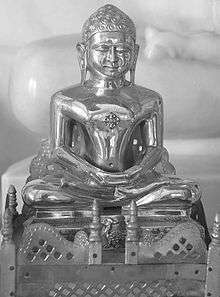Sumatinatha
| Sumatinatha | |
|---|---|
| Fifth Jain Tirthankara | |
 Image of Sumatinatha at a Jain temple | |
| Symbol | Goose |
| Height | 300 bows (900 meters) |
| Age | 4,000,000 purva (282.24 Quintillion Years Old) |
| Tree | Priyangu |
| Color | Golden |
| Parents |
|
| Preceded by | Abhinandananatha |
| Succeeded by | Padmaprabha |
| Born | Ayodhya |
| Moksha | Shikharji |
| Part of a series on |
| Jainism |
|---|
 |
|
Jain prayers |
|
Ethics |
|
Major figures |
|
Major sects |
|
Festivals |
|
Pilgrimages |
|
|
Sumatinatha was the fifth Jain Tirthankara of the present age (Avasarpini). Sumatinatha was born to Kshatriya King Megha (Meghaprabha) and Queen Mangala (Sumangala) at Ayodhya in the Ikshvaku dynasty. His birth date was the eighth day of the Vaisakha shukla month of the Hindu calendar.
Tradition
Sumatinatha was the fifth Jain Tirthankara of the present age (Avasarpini).[1] Sumatinatha was born to Kshatriya King Megha (Meghaprabha) and Queen Mangala (Sumangala) at Ayodhya in the Ikshvaku dynasty. His birth date was the eighth day of the Vaisakha shukla month of the Hindu calendar.[1]
He attained Kevala Jnana under sala or priyangu tree.[2] According to Jain beliefs, he became a siddha, a liberated soul which has destroyed all of its karma. Sumithanatha is associated with Heron (Krauncha) emblem, Priyangu tree, Tumburu (Purushadatta) Yaksha and Mahakala Yakshi.[3]
In his previous incarnation, Sumatinatha was an Indra in the Jayanta Vimana.[4]
Adoration
Svayambhustotra by Acharya Samantabhadra is the adoration of twenty-four tirthankaras. Its five slokas (aphorisms) are dedicated to Sumatinātha.[5] Last of which is:
The attributes of existence and non-existence in an object are valid from particular standpoints; the validity of the statement is contingent on the speaker’s choice, at that particular moment, of the attribute that he wishes to bring to the fore as the other attribute is relegated to the background. O Lord Sumatinātha, you had thus explained the reality of substances; may your adoration augment my intellect![6]
See also
| Wikimedia Commons has media related to Sumatinatha. |
Notes
- 1 2 Tukol 1980, p. 31.
- ↑ Krishna & Amirthalingam 2014, p. 46.
- ↑ Tandon 2002, p. 44.
- ↑ Umakant P. Shah 1987, p. 136.
- ↑ Vijay K. Jain 2015, p. 28-35.
- ↑ Vijay K. Jain 2015, p. 35.
References
- Jain, Vijay K. (2015), Acarya Samantabhadra's Svayambhustotra: Adoration of The Twenty-four Tirthankara, Vikalp Printers, ISBN 978-81-903639-7-6,
 This article incorporates text from this source, which is in the public domain.
This article incorporates text from this source, which is in the public domain. - Krishna, Nanditha; Amirthalingam, M. (2014) [2013], Sacred Plants of India, Penguin Books, ISBN 978-9-351-18691-5
- Shah, Umakant Premanand (1987), Jaina-rūpa-maṇḍana: Jaina iconography, Abhinav Publications, ISBN 81-7017-208-X
- Tandon, Om Prakash (2002) [1968], Jaina Shrines in India (1 ed.), New Delhi: Publications Division, Ministry of Information and Broadcasting, Government of India, ISBN 81-230-1013-3
- Tukol, T. K. (1980), Compendium of Jainism, Dharwad: University of Karnataka